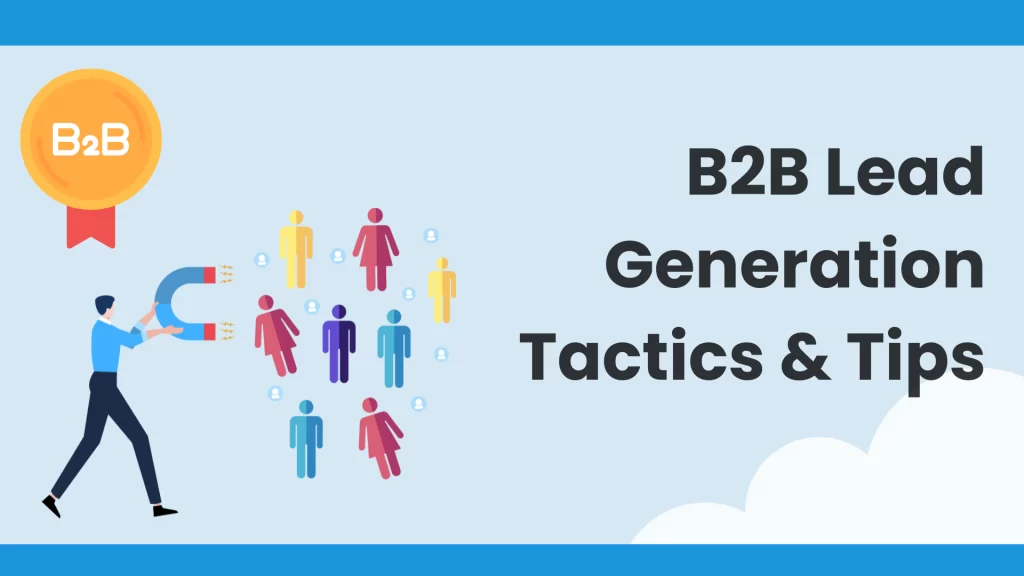In the fast-paced world of B2B marketing, generating a large volume of leads is no longer the ultimate goal—quality trumps quantity. Modern B2B companies understand that success lies in attracting leads that are not just interested, but qualified and likely to convert. Effective lead generation in the B2B space requires a strategic mix of targeting, content, technology, and personalization. In this blog, we’ll explore proven B2B lead generation tactics designed to bring in high-quality leads and fuel sustainable business growth.
Define and Target the Right Audience –
The cornerstone of high-quality lead generation is a deep understanding of your target audience. Developing an Ideal Customer Profile (ICP) and detailed buyer personas helps you focus on companies and individuals who are the best fit for your product or service. Use firmographics such as company size, industry, revenue, and location, as well as behavioral indicators like pain points, goals, and purchase triggers. This clarity allows your marketing and sales teams to prioritize efforts where they matter most, avoiding wasted resources on low-value prospects.
Create Value-Driven Content –
Content remains the most effective way to attract and nurture leads in the B2B space. However, generic blogs and surface-level articles won’t cut it. High-quality leads are drawn to in-depth, actionable content that solves specific problems. Whitepapers, case studies, eBooks, comparison guides, and thought leadership articles are excellent formats to build trust and demonstrate expertise. By offering gated content—resources that require users to submit their contact information—you can also collect valuable lead data for follow-up.
Leverage LinkedIn for Precision Outreach –
When it comes to professional networking and lead generation, LinkedIn is unmatched in the B2B arena. Its advanced targeting tools allow you to reach decision-makers based on job titles, company size, industry, and more. Whether through organic posting, InMail outreach, or paid ads, LinkedIn offers a powerful platform to connect with your ideal audience. Combine this with personalized messaging and relevant content to increase engagement and move prospects further down the funnel.
Utilize Account-Based Marketing (ABM) –
For businesses targeting enterprise clients or long-term contracts, Account-Based Marketing (ABM) is a game-changer. ABM flips the traditional funnel by identifying high-value accounts first and then crafting highly personalized campaigns to engage them. This might involve customized email sequences, tailored landing pages, and content that addresses the specific challenges of each account. When marketing and sales align around the same target accounts, the result is higher conversion rates and stronger customer relationships.
Host Educational Webinars and Events –
Live webinars and virtual events continue to be powerful tools for lead generation. They allow you to showcase expertise, share insights, and interact directly with your audience. Choose topics that reflect the pain points of your target audience and promote your events through email marketing, social channels, and industry groups. Attendees are often more engaged and interested in your offerings, making them ideal candidates for nurturing and conversion efforts.
Optimize Website and Landing Pages –
Your website plays a critical role in converting visitors into leads. Ensure your landing pages are optimized for conversions with compelling headlines, concise copy, benefit-oriented messaging, and prominent calls-to-action. Include social proof like testimonials or trust badges to reinforce credibility. A/B testing different elements—like CTA buttons, images, or form fields—can further improve conversion rates and ensure you’re capturing the highest-quality leads possible.
Use Marketing Automation and Lead Scoring –
Not all leads are created equal, and treating them the same can waste time and resources. Implementing marketing automation platforms like HubSpot, Marketo, or Pardot allows you to nurture leads over time through personalized email sequences and content delivery. Incorporate lead scoring to assign values based on behaviors such as email opens, downloads, and page visits. This lets your sales team focus on the most promising leads and engage them at the right moment.
Run Targeted Paid Advertising Campaigns –
While organic methods build long-term visibility, paid campaigns provide a fast track to high-quality leads. Platforms like Google Ads, LinkedIn Ads, and programmatic networks offer robust targeting options to reach niche audiences. Focus on high-intent keywords and retargeting strategies to capture leads who are already familiar with your brand or have expressed interest in your offerings. Monitor performance metrics like click-through rates (CTR), cost per lead (CPL), and conversion rates to continuously refine your strategy.
Conclusion –
High-quality B2B lead generation doesn’t happen by chance—it requires a thoughtful, data-driven approach. By defining your ideal customer, delivering value through strategic content, leveraging the right platforms, and aligning sales and marketing, you can build a lead generation engine that consistently drives business growth. Whether through ABM, LinkedIn outreach, or educational content, the key lies in understanding your audience and providing solutions that speak directly to their needs. In a market where competition is fierce, those who prioritize lead quality over quantity will always come out ahead.

